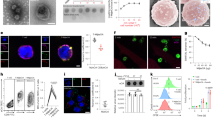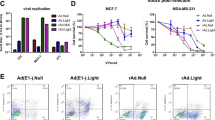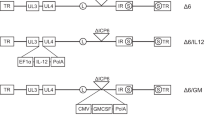Abstract
Recombinant adenoviral vectors (AdVTNF-α) expressing α tumor necrosis factor (TNF-α) under control of cytomegalovirus (CMV) promoter have been used in cancer gene therapy. To reduce its cytotoxicity, we constructed a recombinant AdVTERTmTNF-α expressing a mutant TNF-α (mTNF-α) with mutations at D142N and A144R under control of human telomerase reverse transcriptase (hTERT) promoter for treatment of well-established ovalbumin (OVA)-expressing murine B16 melanoma (BL6-10OVA) (6 mm in diameter). We demonstrated that the mTNF-α with mutations at D142N and A144R has less in vitro cytotoxicity, but maintains its functional effect in the stimulation of T-cell proliferation. The in vitro and in vivo transgene expressions under control of hTERT promoter are highly restricted in tumor cells compared with those under the control of the CMV promoter. AdVTERTmTNF-α gene therapy by intratumoral injection of AdVTERTmTNF-α vector (2 × 109 PFU) expressing the mutant mTNF-α under control of hTERT promoter reduces its in vivo toxicity, eradicates well-established BL6-10OVA tumors in 4/10 tumor-bearing mice, and induces OVA-specific CD8+ T-cell-mediated long-term antitumor immunity. Therefore, AdVTERTmTNF-α gene therapy may be very useful in the immunotherapy of cancer.
This is a preview of subscription content, access via your institution
Access options
Subscribe to this journal
Receive 12 print issues and online access
$259.00 per year
only $21.58 per issue
Buy this article
- Purchase on Springer Link
- Instant access to full article PDF
Prices may be subject to local taxes which are calculated during checkout




Similar content being viewed by others
References
Carswell EA, Old LJ, Kassel RL, Green S, Fiore N, Williamson B . An endotoxin-induced serum factor that causes necrosis of tumors. Proc Natl Acad Sci USA 1975; 72: 3666–3670.
Talmadge JE, Phillips H, Schneider M, Rowe T, Pennington R, Bowersox O et al. Immunomodulatory properties of recombinant murine and human tumor necrosis factor. Cancer Res 1988; 48: 544–550.
Tracey KJ, Cerami A . Tumor necrosis factor: a pleiotropic cytokine and therapeutic target. Annu Rev Med 1994; 45: 491–503.
Mueller H . Tumor necrosis factor as an antineoplastic agent: pitfalls and promises. Cell Mol Life Sci 1998; 54: 1291–1298.
Asher A, Mule JJ, Reichert CM, Shiloni E, Rosenberg SA . Studies on the anti-tumor efficacy of systemically administered recombinant tumor necrosis factor against several murine tumors in vivo. J Immunol 1987; 138: 963–974.
Renard N, Lienard D, Lespagnard L, Eggermont A, Heimann R, Lejeune F . Early endothelium activation and polymorphonuclear cell invasion precede specific necrosis of human melanoma and sarcoma treated by intravascular high-dose tumour necrosis factor alpha (rTNF alpha). Int J Cancer 1994; 57: 656–663.
Fukumura D, Salehi HA, Witwer B, Tuma RF, Melder RJ, Jain RK . Tumor necrosis factor alpha-induced leukocyte adhesion in normal and tumor vessels: effect of tumor type, transplantation site, and host strain. Cancer Res 1995; 55: 4824–4829.
Feinberg B, Kurzrock R, Talpaz M, Blick M, Saks S, Gutterman JU . A phase I trial of intravenously-administered recombinant tumor necrosis factor-alpha in cancer patients. J Clin Oncol 1988; 6: 1328–1334.
Moritz T, Niederle N, Baumann J, May D, Kurschel E, Osieka R et al. Phase I study of recombinant human tumor necrosis factor alpha in advanced malignant disease. Cancer Immunol Immunother 1989; 29: 144–150.
Spriggs DR, Sherman ML, Michie H, Arthur KA, Imamura K, Wilmore D et al. Recombinant human tumor necrosis factor administered as a 24-h intravenous infusion. A phase I and pharmacologic study. J Natl Cancer Inst 1988; 80: 1039–1044.
Fiers W . Tumor necrosis factor. Characterization at the molecular, cellular and in vivo level. FEBS Lett 1991; 285: 199–212.
Marr RA, Hitt M, Gauldie J, Muller WJ, Graham FL . A p75 tumor necrosis factor receptor-specific mutant of murine tumor necrosis factor alpha expressed from an adenovirus vector induces an antitumor response with reduced toxicity. Cancer Gene Ther 1999; 6: 465–474.
Benigni F, Faggioni R, Sironi M, Fantuzzi G, Vandenabeele P, Takahashi N et al. TNF receptor p55 plays a major role in centrally mediated increases of serum IL-6 and corticosterone after intracerebroventricular injection of TNF. J Immunol 1996; 157: 5563–5568.
Kim EY, Teh HS . TNF type 2 receptor (p75) lowers the threshold of T cell activation. J Immunol 2001; 167: 6812–6820.
Kim EY, Teh HS . Critical role of TNF receptor type-2 (p75) as a costimulator for IL-2 induction and T cell survival: a functional link to CD28. J Immunol 2004; 173: 4500–4509.
Lienard D, Ewalenko P, Delmotte JJ, Renard N, Lejeune FJ . High-dose recombinant tumor necrosis factor alpha in combination with interferon gamma and melphalan in isolation perfusion of the limbs for melanoma and sarcoma. J Clin Oncol 1992; 10: 52–60.
Thom AK, Alexander HR, Andrich MP, Barker WC, Rosenberg SA, Fraker DL . Cytokine levels and systemic toxicity in patients undergoing isolated limb perfusion with high-dose tumor necrosis factor, interferon gamma, and melphalan. J Clin Oncol 1995; 13: 264–273.
van der Veen AH, Eggermont AM, Seynhaeve AL, van T, ten Hagen TL . Biodistribution and tumor localization of stealth liposomal tumor necrosis factor-alpha in soft tissue sarcoma bearing rats. Int J Cancer 1998; 77: 901–906.
Yang J, Moyana T, Xiang J . A genetically engineered single-chain FV/TNF molecule possesses the anti-tumor immunoreactivity of FV as well as the cytotoxic activity of tumor necrosis factor. Mol Immunol 1995; 32: 873–881.
Curnis F, Sacchi A, Borgna L, Magni F, Gasparri A, Corti A . Enhancement of tumor necrosis factor alpha antitumor immunotherapeutic properties by targeted delivery to aminopeptidase N (CD13). Nat Biotechnol 2000; 18: 1185–1190.
Curnis F, Gasparri A, Sacchi A, Longhi R, Corti A . Coupling tumor necrosis factor-alpha with alphaV integrin ligands improves its antineoplastic activity. Cancer Res 2004; 64: 565–571.
Van Ostade X, Vandenabeele P, Everaerdt B, Loetscher H, Gentz R, Brockhaus M et al. Human TNF mutants with selective activity on the p55 receptor. Nature 1993; 361: 266–269.
Marr RA, Addison CL, Snider D, Muller WJ, Gauldie J, Graham FL . Tumour immunotherapy using an adenoviral vector expressing a membrane-bound mutant of murine TNF alpha. Gene Therapy 1997; 4: 1181–1188.
Marr RA, Hitt M, Muller WJ, Gauldie J, Graham FL . Tumour therapy in mice using adenovirus vectors expressing human TNFa. Int J Oncol 1998; 12: 509–515.
Wright P, Braun R, Babiuk L, Littel-van den Hurk SD, Moyana T, Zheng C et al. Adenovirus-mediated TNF-alpha gene transfer induces significant tumor regression in mice. Cancer Biother Radiopharm 1999; 14: 49–57.
Kim NW, Piatyszek MA, Prowse KR, Harley CB, West MD, Ho PL et al. Specific association of human telomerase activity with immortal cells and cancer. Science 1994; 266: 2011–2015.
Shay JW, Bacchetti S . A survey of telomerase activity in human cancer. Eur J Cancer 1997; 33: 787–791.
Blackburn EH . Structure and function of telomeres. Nature 1991; 350: 569–573.
Greider CW . Mammalian telomere dynamics: healing, fragmentation shortening and stabilization. Curr Opin Genet Dev 1994; 4: 203–211.
Harrington L, Zhou W, McPhail T, Oulton R, Yeung DS, Mar V et al. Human telomerase contains evolutionarily conserved catalytic and structural subunits. Genes Dev 1997; 11: 3109–3115.
Gu J, Kagawa S, Takakura M, Kyo S, Inoue M, Roth JA et al. Tumor-specific transgene expression from the human telomerase reverse transcriptase promoter enables targeting of the therapeutic effects of the Bax gene to cancers. Cancer Res 2000; 60: 5359–5364.
Gu J, Andreeff M, Roth JA, Fang B . hTERT promoter induces tumor-specific Bax gene expression and cell killing in syngenic mouse tumor model and prevents systemic toxicity. Gene Therapy 2002; 9: 30–37.
Yao X, Yoshioka Y, Eto Y, Morishige T, Okada Y, Mizuguchi H et al. TERT promoter-driven adenovirus vector for cancer gene therapy via systemic injection. Biochem Biophys Res Commun 2007; 362: 419–424.
Chen Z, Moyana T, Saxena A, Warrington R, Jia Z, Xiang J . Efficient antitumor immunity derived from maturation of dendritic cells that had phagocytosed apoptotic/necrotic tumor cells. Int J Cancer 2001; 93: 539–548.
Xiang J, Huang H, Liu Y . A new dynamic model of CD8+ T effector cell responses via CD4+ T helper-antigen-presenting cells. J Immunol 2005; 174: 7497–7505.
Yang J, Jia Z, Xiang J . Substitution of surface-exposed framework residues alters secretion of recombinant fusion protein Fv/tumor necrosis factor in Escherichia coli. IUBMB Life 1999; 48: 327–332.
Ye Z, Shi M, Chan T, Sas S, Xu S, Xiang J . Engineered CD8+ cytotoxic T cells with fiber-modified adenovirus-mediated TNF-alpha gene transfection counteract immunosuppressive interleukin-10-secreting lung metastasis and solid tumors. Cancer Gene Ther 2007; 14: 661–675.
Wright P, Zheng C, Moyana T, Xiang J . Intratumoral vaccination of adenoviruses expressing fusion protein RM4/tumor necrosis factor (TNF)-alpha induces significant tumor regression. Cancer Gene Ther 1998; 5: 371–379.
Xiang J, Moyana T, Qi Y . Genetic engineering of a recombinant fusion possessing anti-tumor F(ab’)2 and tumor necrosis factor. J Biotechnol 1997; 53: 3–12.
Campbell I, Magliocco A, Moyana T, Zheng C, Xiang J . Adenovirus-mediated p16INK4 gene transfer significantly suppresses human breast cancer growth. Cancer Gene Ther 2000; 7: 1270–1278.
Liu Y, Xia D, Li F, Zheng C, Xiang J . Intratumoral administration of immature dendritic cells following the adenovirus vector encoding CD40 ligand elicits significant regression of established myeloma. Cancer Gene Ther 2005; 12: 122–132.
Dyer MR, Herrling PL . Progress and potential for gene-based medicines. Mol Ther 2000; 1: 213–224.
Marshall E . Gene therapy. Second child in French trial is found to have leukemia. Science 2003; 299: 320.
Graham FL . Adenovirus vectors for high-efficiency gene transfer into mammalian cells. Immunol Today 2000; 21: 426–428.
Chen L, Chen D, Manome Y, Dong Y, Fine HA, Kufe DW . Breast cancer selective gene expression and therapy mediated by recombinant adenoviruses containing the DF3/MUC1 promoter. J Clin Invest 1995; 96: 2775–2782.
Osaki T, Tanio Y, Tachibana I, Hosoe S, Kumagai T, Kawase I et al. Gene therapy for carcinoembryonic antigen-producing human lung cancer cells by cell type-specific expression of herpes simplex virus thymidine kinase gene. Cancer Res 1994; 54: 5258–5261.
Parr MJ, Manome Y, Tanaka T, Wen P, Kufe DW, Kaelin Jr WG et al. Tumor-selective transgene expression in vivo mediated by an E2F-responsive adenoviral vector. Nat Med 1997; 3: 1145–1149.
Vile RG, Hart IR . In vitro and in vivo targeting of gene expression to melanoma cells. Cancer Res 1993; 53: 962–967.
Ruegg C, Yilmaz A, Bieler G, Bamat J, Chaubert P, Lejeune FJ . Evidence for the involvement of endothelial cell integrin alphaVbeta3 in the disruption of the tumor vasculature induced by TNF and IFN-gamma. Nat Med 1998; 4: 408–414.
Denekamp J . Review article: angiogenesis, neovascular proliferation and vascular pathophysiology as targets for cancer therapy. Br J Radiol 1993; 66: 181–196.
Ronchetti A, Iezzi G, Crosti MC, Garancini MP, Protti MP, Bellone M . Role of antigen-presenting cells in cross-priming of cytotoxic T lymphocytes by apoptotic cells. J Leukoc Biol 1999; 66: 247–251.
Sauter B, Albert ML, Francisco L, Larsson M, Somersan S, Bhardwaj N . Consequences of cell death: exposure to necrotic tumor cells, but not primary tissue cells or apoptotic cells, induces the maturation of immunostimulatory dendritic cells. J Exp Med 2000; 191: 423–434.
Bodnar AG, Ouellette M, Frolkis M, Holt SE, Chiu CP, Morin GB et al. Extension of life-span by introduction of telomerase into normal human cells. Science 1998; 279: 349–352.
Frolkis M, Fischer MB, Wang Z, Lebkowski JS, Chiu CP, Majumdar AS . Dendritic cells reconstituted with human telomerase gene induce potent cytotoxic T-cell response against different types of tumors. Cancer Gene Ther 2003; 10: 239–249.
Chen L, Liang GP, Tang XD, Chen T, Cai YG, Fang DC et al. In vitro anti-tumor immune response induced by dendritic cells transfected with hTERT recombinant adenovirus. Biochem Biophys Res Commun 2006; 351: 927–934.
Acknowledgements
This study was supported by research grants of Canadian Institutes of Health Research (MOP 81228).
Author information
Authors and Affiliations
Corresponding author
Rights and permissions
About this article
Cite this article
Xiang, J., Munegowda, M. & Deng, Y. Transgene expression of α tumor necrosis factor with mutations D142N and A144R under control of human telomerase reverse transcriptase promoter eradicates well-established tumors and induces long-term antitumor immunity. Cancer Gene Ther 16, 430–438 (2009). https://doi.org/10.1038/cgt.2008.94
Received:
Revised:
Accepted:
Published:
Issue Date:
DOI: https://doi.org/10.1038/cgt.2008.94



